Submitted:
16 January 2023
Posted:
16 January 2023
You are already at the latest version
Abstract
Keywords:
1. Introduction
2. 2D Materials
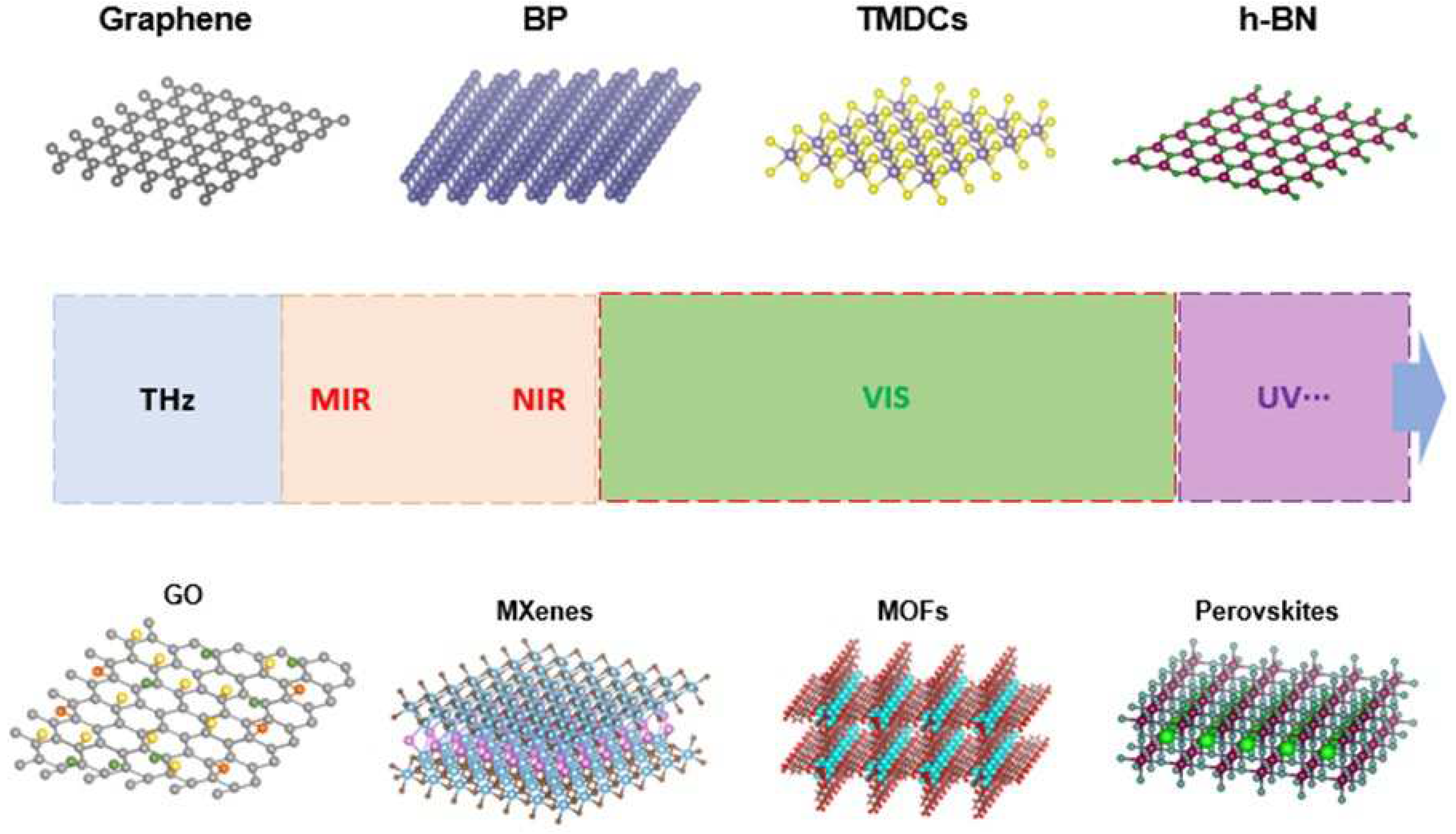
2.1. Graphene and graphene oxide
2.2. Transition Metal Dichalcogenides
2.3. Black Phosphorus
2.4. Other Emerging 2D Materials
3. Third-Order Optical Nonlinearities of 2D Materials in the Telecommunications Band
3.1. Third-Order Optical Nonlinearity
3.2. Characterization Methods
3.2.1. Z-Scan Technique
3.2.2. THG Measurement
3.2.3. Hybrid Device Characterization
3.3. Comparison of Measured Results
4. Outlook and Prospects
5. Conclusions
Data Availability Statement
Conflicts of Interest
References
- Leuthold, J., C. Koos, and W. Freude, Nonlinear silicon photonics. Nature Photonics, 2010. 4(8): p. 535-544.
- Xia, F., L. Sekaric, and Y. Vlasov, Ultracompact optical buffers on a silicon chip. Nature Photonics, 2007. 1(1): p. 65-71.
- Foster, M.A., et al., Broad-band optical parametric gain on a silicon photonic chip. Nature, 2006. 441(7096): p. 960-3.
- Razzari, L., et al., CMOS-compatible integrated optical hyper-parametric oscillator. Nature Photonics, 2009. 4(1): p. 41-45.
- Ferrera, M., et al., Low-power continuous-wave nonlinear optics in doped silica glass integrated waveguide structures. Nature Photonics, 2008. 2(12): p. 737-740.
- Gaeta, A.L., M. Lipson, and T.J. Kippenberg, Photonic-chip-based frequency combs. Nature Photonics, 2019. 13(3): p. 158-169.
- Demongodin, P., et al., Ultrafast saturable absorption dynamics in hybrid graphene/Si3N4 waveguides. APL Photonics, 2019. 4(7): p. 076102.
- Aitchison, J.S., et al., The nonlinear optical properties of AlGaAs at the half band gap. IEEE Journal of Quantum Electronics, 1997. 33(3): p. 341-348.
- Kawashima, H., et al., Optical Bistable Response in AlGaAs-Based Photonic Crystal Microcavities and Related Nonlinearities. IEEE Journal of Quantum Electronics, 2008. 44(9): p. 841-849.
- Xie, W., et al., Ultrahigh-Q AlGaAs-on-insulator microresonators for integrated nonlinear photonics. Opt Express, 2020. 28(22): p. 32894-32906.
- Nicoletti, E., et al., Generation of lambda/12 nanowires in chalcogenide glasses. Nano Lett, 2011. 11(10): p. 4218-21.
- Eggleton, B.J., B. Luther-Davies, and K. Richardson, Chalcogenide photonics. Nature Photonics, 2011. 5(3): p. 141-148.
- Liang, T.K. and H.K. Tsang, Efficient Raman amplification in silicon-on-insulator waveguides. Applied Physics Letters, 2004. 85(16): p. 3343-3345.
- Yamashita, D., et al., Strongly asymmetric wavelength dependence of optical gain in nanocavity-based Raman silicon lasers. Optica, 2018. 5(10): p. 1256.
- Zhang, Y., K. Zhong, and H.K. Tsang, Raman Lasing in Multimode Silicon Racetrack Resonators. Laser & Photonics Reviews, 2020. 15(2): p. 2000336.
- Salem, R., et al., Signal regeneration using low-power four-wave mixing on silicon chip. Nature Photonics, 2008. 2(1): p. 35-38.
- Mathlouthi, W., H. Rong, and M. Paniccia, Characterization of efficient wavelength conversion by four-wave mixing in sub-micron silicon waveguides. Optics Express, 2008. 16(21): p. 16735-16745.
- Frigg, A., et al., Optical frequency comb generation with low temperature reactive sputtered silicon nitride waveguides. APL Photonics, 2020. 5(1): p. 011302.
- Li, F., et al., All-optical XOR logic gate for 40Gb/s DPSK signals via FWM in a silicon nanowire. Optics Express, 2011. 19(21): p. 20364-20371.
- Gao, S., et al., Reconfigurable dual-channel all-optical logic gate in a silicon waveguide using polarization encoding. Optics Letters, 2015. 40(7): p. 1448-1451.
- Soref, R., et al., Silicon-Based Group-IV O-E-O Devices for Gain, Logic, and Wavelength Conversion. ACS Photonics, 2020. 7(3): p. 800-811.
- Monat, C., et al., Integrated optical auto-correlator based on third-harmonic generation in a silicon photonic crystal waveguide. Nat Commun, 2014. 5: p. 3246.
- Wu, J., et al., RF Photonics: An Optical Microcombs’ Perspective. IEEE Journal of Selected Topics in Quantum Electronics, 2018. 24(4): p. 1-20.
- Xu, X., et al., Broadband RF Channelizer Based on an Integrated Optical Frequency Kerr Comb Source. Journal of Lightwave Technology, 2018. 36(19): p. 4519-4526.
- Xu, X., et al., Microcomb-Based Photonic RF Signal Processing. IEEE Photonics Technology Letters, 2019. 31(23): p. 1854-1857.
- Corcoran, B., et al., Ultra-dense optical data transmission over standard fibre with a single chip source. Nat Commun, 2020. 11(1): p. 2568.
- Fridman, M., et al., Demonstration of temporal cloaking. Nature, 2012. 481(7379): p. 62-65.
- Christian Reimer, M.K., Piotr Roztocki, Benjamin Wetzel, Fabio Grazioso, Brent E. Little, Sai T. Chu, Tudor Johnston, Yaron Bromberg, Lucia Caspani, David J. Moss, Roberto Morandotti,, Generation of multiphoton entangled quantum states by means of integrated frequency combs. Science, 2016. 351(6278): p. 4.
- Kues, M., et al., On-chip generation of high-dimensional entangled quantum states and their coherent control. Nature, 2017. 546(7660): p. 622-626.
- Caspani, L., et al., Integrated sources of photon quantum states based on nonlinear optics. Light Sci Appl, 2017. 6(11): p. e17100.
- Geim, A.K. and K.S. Novoselov, The rise of graphene. Nature materials, 2007. 6(3): p. 183-191.
- Yang, T., et al., Tailoring pores in graphene-based materials: from generation to applications. Journal of Materials Chemistry A, 2017. 5(32): p. 16537-16558.
- Bolotin, K.I., et al., Temperature-dependent transport in suspended graphene. Phys Rev Lett, 2008. 101(9): p. 096802.
- Loh, K.P., et al., Graphene oxide as a chemically tunable platform for optical applications. Nat Chem, 2010. 2(12): p. 1015-24.
- Ghofraniha, N. and C. Conti, Graphene oxide photonics. Journal of Optics, 2019. 21(5): p. 053001.
- Luo, Z., et al., Photoluminescence and band gap modulation in graphene oxide. Applied Physics Letters, 2009. 94(11): p. 111909.
- Tian, H., et al., Optoelectronic devices based on two-dimensional transition metal dichalcogenides. Nano Research, 2016. 9(6): p. 1543-1560.
- Tan, T., et al., 2D Material Optoelectronics for Information Functional Device Applications: Status and Challenges. Adv Sci, 2020. 7(11): p. 2000058.
- Liang, Q., et al., High-Performance, Room Temperature, Ultra-Broadband Photodetectors Based on Air-Stable PdSe2. Adv Mater, 2019. 31(24): p. e1807609.
- Pi, L., et al., Recent Progress on 2D Noble-Transition-Metal Dichalcogenides. Advanced Functional Materials, 2019. 29(51): p. 1904932.
- Zhang, K., et al., Two dimensional hexagonal boron nitride (2D-hBN): synthesis, properties and applications. Journal of Materials Chemistry C, 2017. 5(46): p. 11992-12022.
- Tran, T.T., et al., Quantum emission from hexagonal boron nitride monolayers. Nat Nanotechnol, 2016. 11(1): p. 37-41.
- Caldwell, J.D., et al., Photonics with hexagonal boron nitride. Nature Reviews Materials, 2019. 4(8): p. 552-567.
- Autere, A., et al., Nonlinear Optics with 2D Layered Materials. Adv Mater, 2018. 30(24): p. 1705963.
- Qiao, J., et al., High-mobility transport anisotropy and linear dichroism in few-layer black phosphorus. Nature Communications, 2014. 5(1): p. 4475.
- Yuan, H., et al., Polarization-sensitive broadband photodetector using a black phosphorus vertical p–n junction. Nature Nanotechnology, 2015. 10(8): p. 707-713.
- Guo, Q., et al., Black Phosphorus Mid-Infrared Photodetectors with High Gain. Nano Letters, 2016. 16(7): p. 4648-4655.
- Li, L., et al., Direct observation of the layer-dependent electronic structure in phosphorene. Nat Nanotechnol, 2017. 12(1): p. 21-25.
- Radisavljevic, B., et al., Single-layer MoS2 transistors. Nat Nanotechnol, 2011. 6(3): p. 147-50.
- Fang, H., et al., High performance single layered WSe2 p-FETs with chemically doped contacts. Nano Lett, 2012. 12(7): p. 3788-92.
- Michael M. Lee, J.T., Tsutomu Miyasaka, Takurou N. Murakami, and Henry J. Snaith, Efficient Hybrid Solar Cells Based on Meso-Superstructured Organometal Halide Perovskites. Science, 2012. 338(6107): p. 643-647.
- Xing, J., et al., High-Efficiency Light-Emitting Diodes of Organometal Halide Perovskite Amorphous Nanoparticles. ACS Nano, 2016. 10(7): p. 6623-30.
- Zhang, J., et al., Thickness-dependent nonlinear optical properties of CsPbBr3 perovskite nanosheets. Opt Lett, 2017. 42(17): p. 3371-3374.
- Sun, Z., et al., Graphene Mode-Locked Ultrafast Laser. ACS nano, 2010. 4(2): p. 803-810.
- Zhang, J., et al., Ultrafast saturable absorption of MoS2 nanosheets under different pulse-width excitation conditions. Opt Lett, 2018. 43(2): p. 243-246.
- Liu, Y., et al., Investigation of mode coupling in normal-dispersion silicon nitride microresonators for Kerr frequency comb generation. Optica, 2014. 1(3): p. 137.
- Jiang, X., et al., Broadband Nonlinear Photonics in Few-Layer MXene Ti3C2Tx (T = F, O, or OH). Laser & Photonics Reviews, 2018. 12(2): p. 1700229.
- Demetriou, G., et al., Nonlinear optical properties of multilayer graphene in the infrared. Opt Express, 2016. 24(12): p. 13033-43.
- Zheng, X., et al., In situ third-order non-linear responses during laser reduction of graphene oxide thin films towards on-chip non-linear photonic devices. Adv Mater, 2014. 26(17): p. 2699-703.
- Xu, X., et al., Observation of Third-order Nonlinearities in Graphene Oxide Film at Telecommunication Wavelengths. Sci Rep, 2017. 7(1): p. 9646.
- Jia, L., et al., Highly nonlinear BiOBr nanoflakes for hybrid integrated photonics. APL Photonics, 2019. 4(9): p. 090802.
- Jia, L.N., et al., Large Third-Order Optical Kerr Nonlinearity in Nanometer-Thick PdSe2 2D Dichalcogenide Films: Implications for Nonlinear Photonic Devices. Acs Applied Nano Materials, 2020. 3(7): p. 6876-6883.
- Yoshikawa, N., T. Tamaya, and K. Tanaka, High-harmonic generation in graphene enhanced by elliptically polarized light excitation. Science, 2017. 356(6339): p. 736-738.
- Janisch, C., et al., Extraordinary Second Harmonic Generation in tungsten disulfide monolayers. Sci Rep, 2014. 4: p. 5530.
- Youngblood, N., et al., Layer-Tunable Third-Harmonic Generation in Multilayer Black Phosphorus. ACS Photonics, 2016. 4(1): p. 8-14.
- Jiang, T., et al., Ultrafast coherent nonlinear nanooptics and nanoimaging of graphene. Nat Nanotechnol, 2019. 14(9): p. 838-843.
- Foster, M.A., et al., Silicon-chip-based ultrafast optical oscilloscope. Nature, 2008. 456(7218): p. 81-4.
- Zhong, H.-S., et al., Quantum computational advantage using photons. Science, 2020. 370(6523): p. 1460.
- Chen, W., et al., Nonlinear Photonics Using Low-Dimensional Metal-Halide Perovskites: Recent Advances and Future Challenges. Adv Mater, 2021. 33(11): p. e2004446.
- Liu, W., et al., Recent Advances of 2D Materials in Nonlinear Photonics and Fiber Lasers. Advanced Optical Materials, 2020. 8(8): p. 1901631.
- Nair, R.R., et al., Fine Structure Constant Defines Visual Transparency of Graphene. Science, 2008. 320(5881): p. 1308.
- Lui, C.H., et al., Ultrafast Photoluminescence from Graphene. Physical Review Letters, 2010. 105(12): p. 127404.
- Sun, Z., A. Martinez, and F. Wang, Optical modulators with 2D layered materials. Nature Photonics, 2016. 10(4): p. 227-238.
- Li, J.Z.L.L.F., Graphene Oxide-Physics and Applications. 2015.
- Bao, Q., et al., Atomic-Layer Graphene as a Saturable Absorber for Ultrafast Pulsed Lasers. Advanced Functional Materials, 2009. 19(19): p. 3077-3083.
- Zhu, G., et al., Graphene Mode-Locked Fiber Laser at 2.8 <inline-formula> <tex-math notation="LaTeX">$\mu \text{m}$ </tex-math></inline-formula>. IEEE Photonics Technology Letters, 2016. 28(1): p. 7-10.
- Wu, R., et al., Purely coherent nonlinear optical response in solution dispersions of graphene sheets. Nano Lett, 2011. 11(12): p. 5159-64.
- Wu, J., et al., 2D Layered Graphene Oxide Films Integrated with Micro-Ring Resonators for Enhanced Nonlinear Optics. Small, 2020. 16(16): p. e1906563.
- Hendry, E., et al., Coherent nonlinear optical response of graphene. Phys Rev Lett, 2010. 105(9): p. 097401.
- Splendiani, A., et al., Emerging photoluminescence in monolayer MoS2. Nano Lett, 2010. 10(4): p. 1271-5.
- Mak, K.F., D. Xiao, and J. Shan, Light–valley interactions in 2D semiconductors. Nature Photonics, 2018. 12(8): p. 451-460.
- Xu, N., et al., Palladium diselenide as a direct absorption saturable absorber for ultrafast mode-locked operations: from all anomalous dispersion to all normal dispersion. Nanophotonics, 2020. 0(0).
- Yang, T., et al., Anisotropic Third-Order Nonlinearity in Pristine and Lithium Hydride Intercalated Black Phosphorus. ACS Photonics, 2018. 5(12): p. 4969-4977.
- Zhao, Y., et al., Recent advance in black phosphorus: Properties and applications. Materials Chemistry and Physics, 2017. 189: p. 215-229.
- Wu, H.-Y., Y. Yen, and C.-H. Liu, Observation of polarization and thickness dependent third-harmonic generation in multilayer black phosphorus. Applied Physics Letters, 2016. 109(26).
- Wang, Y., et al., Ultrafast recovery time and broadband saturable absorption properties of black phosphorus suspension. Applied Physics Letters, 2015. 107(9): p. 091905.
- Wang, K., et al., Ultrafast Nonlinear Excitation Dynamics of Black Phosphorus Nanosheets from Visible to Mid-Infrared. ACS Nano, 2016. 10(7): p. 6923-32.
- Luo, Z.C., et al., Microfiber-based few-layer black phosphorus saturable absorber for ultra-fast fiber laser. Opt Express, 2015. 23(15): p. 20030-9.
- Wang, J., F. Ma, and M. Sun, Graphene, hexagonal boron nitride, and their heterostructures: properties and applications. RSC Advances, 2017. 7(27): p. 16801-16822.
- Naguib, M., et al., Two-dimensional nanocrystals produced by exfoliation of Ti3 AlC2. Adv Mater, 2011. 23(37): p. 4248-53.
- Dillon, A.D., et al., Highly Conductive Optical Quality Solution-Processed Films of 2D Titanium Carbide. Advanced Functional Materials, 2016. 26(23): p. 4162-4168.
- Stranks, S.D. and H.J. Snaith, Metal-halide perovskites for photovoltaic and light-emitting devices. Nature Nanotechnology, 2015. 10(5): p. 391-402.
- Gu, C., et al., Giant and Multistage Nonlinear Optical Response in Porphyrin-Based Surface-Supported Metal-Organic Framework Nanofilms. Nano Lett, 2019. 19(12): p. 9095-9101.
- Liu, W., et al., Structural Engineering of Low-Dimensional Metal-Organic Frameworks: Synthesis, Properties, and Applications. Adv Sci, 2019. 6(12): p. 1802373.
- Medishetty, R., et al., Nonlinear optical properties, upconversion and lasing in metal-organic frameworks. Chem Soc Rev, 2017. 46(16): p. 4976-5004.
- Zheng, Y., et al., Recent Progress in 2D Metal-Organic Frameworks for Optical Applications. Advanced Optical Materials, 2020. 8(13): p. 2000110.
- Boyd, R.W., Nonlinear Optics. Elsevier, Rochester, NY, USA, 2007.
- Moss, D.J., et al., New CMOS-compatible platforms based on silicon nitride and Hydex for nonlinear optics. Nature Photonics, 2013. 7(8): p. 597-607.
- Zhang, Y., et al., Enhanced Kerr Nonlinearity and Nonlinear Figure of Merit in Silicon Nanowires Integrated with 2D Graphene Oxide Films. ACS Appl Mater Interfaces, 2020. 12(29): p. 33094-33103.
- Li, Y., et al., All-optical RF spectrum analyzer with a 5 THz bandwidth based on CMOS-compatible high-index doped silica waveguides. Optics Letters, 2021. 46(7): p. 1574.
- Ferrera, M., et al., CMOS compatible integrated all-optical radio frequency spectrum analyzer. Opt Express, 2014. 22(18): p. 21488-98.
- Corcoran, B., et al., Green light emission in silicon through slow-light enhanced third-harmonic generation in photonic-crystal waveguides. Nature Photonics, 2009. 3(4): p. 206-210.
- Corcoran, B., et al., Optical signal processing on a silicon chip at 640Gb/s using slow-light. Optics Express, 2010. 18(8): p. 7770-7781.
- Mansoor Sheik-Bahae, A.A.S., Tai-Huei Wei, David J. Hagan and E. W . Van Stryland, Sensitive Measurement of Optical Nonlinearities Using a Single Beam. IEEE JOURNAL OF QUANTUM ELECTRONICS, 1990. 26(4): p. 10.
- Zhang, H., et al., Z-scan measurement of the nonlinear refractive index of graphene. Optics Letters, 2012. 37(11): p. 1856-1858.
- Yi, J., et al., Third-order nonlinear optical response of CH_3NH_3PbI_3 perovskite in the mid-infrared regime. Optical Materials Express, 2017. 7(11): p. 3894.
- Xiao, S., et al., Nonlinear optical modulation of MoS2/black phosphorus/MoS2 at 1550 nm. Physica B: Condensed Matter, 2020. 594: p. 412364.
- Novoselov, K.S., et al., 2D materials and van der Waals heterostructures. Science, 2016. 353(6298): p. aac9439.
- Liu, Y., et al., Van der Waals heterostructures and devices. Nature Reviews Materials, 2016. 1(9): p. 16042.
- Wang, Y., et al., Observation of large nonlinear responses in a graphene-Bi2Te3 heterostructure at a telecommunication wavelength. Applied Physics Letters, 2016. 108(22): p. 221901.
- Kumar, N., et al., Third harmonic generation in graphene and few-layer graphite films. Physical Review B, 2013. 87(12): p. 121406.
- Abdelwahab, I., et al., Highly Enhanced Third-Harmonic Generation in 2D Perovskites at Excitonic Resonances. ACS Nano, 2018. 12(1): p. 644-650.
- Jiang, T., et al., Gate-tunable third-order nonlinear optical response of massless Dirac fermions in graphene. Nature Photonics, 2018. 12(7): p. 430-436.
- Rosa, H.G., et al., Characterization of the second- and third-harmonic optical susceptibilities of atomically thin tungsten diselenide. Sci Rep, 2018. 8(1): p. 10035.
- Wang, R., et al., Third-Harmonic Generation in Ultrathin Films of MoS2. ACS Applied Materials & Interfaces, 2014. 6(1): p. 314-318.
- Youngblood, N., et al., Layer-Tunable Third-Harmonic Generation in Multilayer Black Phosphorus. ACS Photonics, 2017. 4(1): p. 8-14.
- Susoma, J., et al., Second and third harmonic generation in few-layer gallium telluride characterized by multiphoton microscopy. Applied Physics Letters, 2016. 108(7): p. 073103.
- Gu, T., et al., Regenerative oscillation and four-wave mixing in graphene optoelectronics. Nature Photonics, 2012. 6(8): p. 554-559.
- Alexander, K., et al., Electrically Tunable Optical Nonlinearities in Graphene-Covered SiN Waveguides Characterized by Four-Wave Mixing. ACS Photonics, 2017. 4(12): p. 3039-3044.
- Yang, Y., et al., Invited Article: Enhanced four-wave mixing in waveguides integrated with graphene oxide. APL Photonics, 2018. 3(12): p. 120803.
- Donnelly, C. and D.T. Tan, Ultra-large nonlinear parameter in graphene-silicon waveguide structures. Optics express, 2014. 22(19): p. 22820-22830.
- Ji, M., et al., Enhanced parametric frequency conversion in a compact silicon-graphene microring resonator. Optics Express, 2015. 23(14): p. 18679-18685.
- Pasquazi, A., et al., All-optical wavelength conversion in an integrated ring resonator. Optics Express, 2010. 18(4): p. 3858-3863.
- M Ferrera et al., “On-Chip ultra-fast 1st and 2nd order CMOS compatible all-optical integration”, Optics Express vol. 19 (23), 23153-23161 (2011).
- VG Ta’eed et al., “Error free all optical wavelength conversion in highly nonlinear As-Se chalcogenide glass fiber”, Optics Express vol. 14 (22), 10371-10376 (2006).
- M Rochette, L Fu, V Ta’eed, DJ Moss, BJ Eggleton, “2R optical regeneration: an all-optical solution for BER improvement”, IEEE Journal of Selected Topics in Quantum Electronics vol. 12 (4), 736-744 (2006).
- TD Vo, et al., “Silicon-chip-based real-time dispersion monitoring for 640 Gbit/s DPSK signals”, Journal of Lightwave Technology vol. 29 (12), 1790-1796 (2011).
- D. Duchesne, M. Peccianti, M. R. E. Lamont, et al., “Supercontinuum generation in a high index doped silica glass spiral waveguide,” Optics Express, vol. 18, no, 2, pp. 923-930, 2010.
- M. Ferrera, et al., “On-chip CMOS-compatible all-optical integrator”, Nature Communications, vol. 1, Article 29, 2010.
- A.Pasquazi, Y. Park, J. Azana, et al., “Efficient wavelength conversion and net parametric gain via Four Wave Mixing in a high index doped silica waveguide,” Optics Express, vol. 18, no. 8, pp. 7634-7641, 2010.
- M. Peccianti, M. Ferrera, L. Razzari, et al., “Subpicosecond optical pulse compression via an integrated nonlinear chirper,” Optics Express, vol. 18, no. 8, pp. 7625-7633, 2010.
- M. Ferrera et al., “Low Power CW Parametric Mixing in a Low Dispersion High Index Doped Silica Glass Micro-Ring Resonator with Q-factor > 1 Million”, Optics Express, vol.17, no. 16, pp. 14098–14103 (2009).
- A. Pasquazi, et al., “Sub-picosecond phase-sensitive optical pulse characterization on a chip”, Nature Photonics, vol. 5, no. 10, pp. 618-623 (2011).
- Xu, X., et al., 11 TOPS photonic convolutional accelerator for optical neural networks. Nature, 2021. 589(7840): p. 44-51.
- Pasquazi, A., et al., Micro-combs: A novel generation of optical sources. Physics Reports, 2018. 729: p. 1-81.
- Bao, C., et al., Direct soliton generation in microresonators, Opt. Lett, 42, 2519 (2017).
- H. Bao, L Olivieri, M Rowley, ST Chu, BE Little, R Morandotti, DJ Moss, et al., “Turing patterns in a fiber laser with a nested microresonator: Robust and controllable microcomb generation”, Physical Review Research 2 (2), 023395 (2020).
- X. Xu, et al., “Advanced RF and microwave functions based on an integrated optical frequency comb source,” Opt. Express, vol. 26 (3) 2569 (2018).
- M. Peccianti, et al., “Demonstration of an ultrafast nonlinear microcavity modelocked laser”, Nature Communications, vol. 3, pp. 765, 2012.
- Yang Sun, Jiayang Wu, Mengxi Tan, Xingyuan Xu, Yang Li, Roberto Morandotti, Arnan Mitchell, and David Moss, “Applications of optical micro-combs”, Advances in Optics and Photonics vol. 14 (2022). [CrossRef]
- M. Kues, et al., “Passively modelocked laser with an ultra-narrow spectral width”, Nature Photonics, vol. 11, no. 3, pp. 159, 2017. A.Pasquazi, et al., “Self-locked optical parametric oscillation in a CMOS compatible microring resonator: a route to robust optical frequency comb generation on a chip,” Optics Express, vol. 21, no. 11, pp. 13333-13341, 2013.
- A.Pasquazi, et al., “Stable, dual mode, high repetition rate mode-locked laser based on a microring resonator,” Optics Express, vol. 20, no. 24, pp. 27355-27362, 2012.
- H. Bao, et al., Laser cavity-soliton microcombs, Nature Photonics, vol. 13, no. 6, pp. 384-389, Jun. 2019.
- Antonio Cutrona, Maxwell Rowley, Debayan Das, Luana Olivieri, Luke Peters, Sai T. Chu, Brent L. Little, Roberto Morandotti, David J. Moss, Juan Sebastian Totero Gongora, Marco Peccianti, Alessia Pasquazi, “High Conversion Efficiency in Laser Cavity-Soliton Microcombs”, Optics Express Vol. 30, Issue 22, pp. 39816-39825 (2022). [CrossRef]
- M.Rowley, P.Hanzard, A.Cutrona, H.Bao, S.Chu, B.Little, R.Morandotti, D. J. Moss, G. Oppo, J. Gongora, M. Peccianti and A. Pasquazi, “Self-emergence of robust solitons in a micro-cavity”, Nature 608 (7922) 303–309 (2022).
- Koos, C., et al., All-optical high-speed signal processing with silicon–organic hybrid slot waveguides. Nature Photonics, 2009. 3(4): p. 216-219.
- Ji, H., et al., Optical Waveform Sampling and Error-Free Demultiplexing of 1.28 Tb/s Serial Data in a Nanoengineered Silicon Waveguide. Journal of Lightwave Technology, 2011. 29(4): p. 426-431.
- Kues, M. et al. “Quantum optical microcombs”, Nature Photonics 13, (3) 170-179 (2019). [CrossRef]
- C.Reimer, et al., “Cross-polarized photon-pair generation and bi-chromatically pumped optical parametric oscillation on a chip”, Nature Communications, vol. 6, Article 8236, 2015. [CrossRef]
- L. Caspani, C. Reimer, M. Kues, et al., “Multifrequency sources of quantum correlated photon pairs on-chip: a path toward integrated Quantum Frequency Combs,” Nanophotonics, vol. 5, no. 2, pp. 351-362, 2016.
- P. Roztocki et al., “Practical system for the generation of pulsed quantum frequency combs,” Optics Express, vol. 25, no. 16, pp. 18940-18949, 2017.
- Y. Zhang, et al., “Induced photon correlations through superposition of two four-wave mixing processes in integrated cavities”, Laser and Photonics Reviews, vol. 14, no. 7, pp. 2000128, 2020. [CrossRef]
- C. Reimer, et al., “High-dimensional one-way quantum processing implemented on d-level cluster states”, Nature Physics, vol. 15, no.2, pp. 148–153, 2019.
- P.Roztocki et al., “Complex quantum state generation and coherent control based on integrated frequency combs”, Journal of Lightwave Technology 37 (2) 338-347 (2019).
- S. Sciara et al., “Generation and Processing of Complex Photon States with Quantum Frequency Combs”, IEEE Photonics Technology Letters 31 (23) 1862-1865 (2019). [CrossRef]
- Stefania Sciara, Piotr Roztocki, Bennet Fisher, Christian Reimer, Luis Romero Cortez, William J. Munro, David J. Moss, Alfonso C. Cino, Lucia Caspani, Michael Kues, J. Azana, and Roberto Morandotti, “Scalable and effective multilevel entangled photon states: A promising tool to boost quantum technologies”, Nanophotonics 10 (18), 4447–4465 (2021). [CrossRef]
- L. Caspani, C. Reimer, M. Kues, et al., “Multifrequency sources of quantum correlated photon pairs on-chip: a path toward integrated Quantum Frequency Combs,” Nanophotonics, vol. 5, no. 2, pp. 351-362, 2016.
- Qu, Y., et al., Enhanced Four-Wave Mixing in Silicon Nitride Waveguides Integrated with 2D Layered Graphene Oxide Films. Advanced Optical Materials, 2020. 8(23): p. 2001048.
- Qu, Y., et al., Analysis of Four-Wave Mixing in Silicon Nitride Waveguides Integrated With 2D Layered Graphene Oxide Films. Journal of Lightwave Technology, 2021. 39(9): p. 2902-2910.
- Feng, Q., et al., Enhanced optical Kerr nonlinearity of graphene/Si hybrid waveguide. Applied Physics Letters, 2019. 114(7).
- Yuning Zhang, Jiayang Wu, Yang Qu, Yunyi Yang, Linnan Jia, Baohua Jia, and David J. Moss, “Enhanced supercontinuum generated in SiN waveguides coated with GO films”, Advanced Materials Technologies 8 (2023). [CrossRef]
- Yuning Zhang, Jiayang Wu, Linnan Jia, Yang Qu, Baohua Jia, and David J. Moss, “Graphene oxide for nonlinear integrated photonics”, Laser and Photonics Reviews 17 (2023). [CrossRef]
- Jiayang Wu, H.Lin, D. J. Moss, T.K. Loh, Baohua Jia, “Graphene oxide: new opportunities for electronics, photonics, and optoelectronics”, Nature Reviews Chemistry 7 (2023). [CrossRef]
- Yang Qu, Jiayang Wu, Yuning Zhang, Yunyi Yang, Linnan Jia, Baohua Jia, and David J. Moss, “Photo thermal tuning in GO-coated integrated waveguides”, Micromachines 13 1194 (2022). [CrossRef]
- Yuning Zhang, Jiayang Wu, Yunyi Yang, Yang Qu, Houssein El Dirani, Romain Crochemore, Corrado Sciancalepore, Pierre Demongodin, Christian Grillet, Christelle Monat, Baohua Jia, and David J. Moss, “Enhanced self-phase modulation in silicon nitride waveguides integrated with 2D graphene oxide films”, IEEE Journal of Selected Topics in Quantum Electronics 28 Early Access (2022). [CrossRef]
- Yuning Zhang, Jiayang Wu, Yunyi Yang, Yang Qu, Linnan Jia, Baohua Jia, and David J. Moss, “Enhanced spectral broadening of femtosecond optical pulses in silicon nanowires integrated with 2D graphene oxide films”, Micromachines 13 756 (2022). [CrossRef]
- Linnan Jia, Jiayang Wu, Yuning Zhang, Yang Qu, Baohua Jia, Zhigang Chen, and David J. Moss, “Fabrication Technologies for the On-Chip Integration of 2D Materials”, Small: Methods 6, 2101435 (2022). [CrossRef]
- Yuning Zhang, Jiayang Wu, Yang Qu, Linnan Jia, Baohua Jia, and David J. Moss, “Design and optimization of four-wave mixing in microring resonators integrated with 2D graphene oxide films”, Journal of Lightwave Technology 39 (20) 6553-6562 (2021).
- Yuning Zhang, Jiayang Wu, Yang Qu, Linnan Jia, Baohua Jia, and David J. Moss, “Optimizing the Kerr nonlinear optical performance of silicon waveguides integrated with 2D graphene oxide films”, Journal of Lightwave Technology vol. 39 (14) 4671-4683 (2021).
- Jiayng Wu, Linnan Jia, Yuning Zhang, Yang Qu, Baohua Jia, and David J. Moss,“ Graphene oxide: versatile films for flat optics to nonlinear photonic chips”, Advanced Materials 33 (3) 2006415, pp.1-29 (2021). [CrossRef]
- Liu, L., et al., Enhanced optical Kerr nonlinearity of MoS_2 on silicon waveguides. Photonics Research, 2015. 3(5): p. 206-209.
- Linnan Jia, Changfu Huo, Xiaoqing Yan, Jiayang Wu, Yunyi Yang, Daohong Song, Baohua Jia, Zhibo Liu, Zhigang Chen, David J. Moss, “Ultrafast carrier dynamics in 2D NbTe2 films”, ACS Applied Nano Materials, Vol. 6 (2023). [CrossRef]
- Guo, J., et al., 2D GeP as a Novel Broadband Nonlinear Optical Material for Ultrafast Photonics. Laser & Photonics Reviews, 2019.
- Jiang, X., et al., Ultrathin Metal–Organic Framework: An Emerging Broadband Nonlinear Optical Material for Ultrafast Photonics. Advanced Optical Materials, 2018. 6(16): p. 1800561.
- Vermeulen, N., et al., Negative Kerr Nonlinearity of Graphene as seen via Chirped-Pulse-Pumped Self-Phase Modulation. Physical Review Applied, 2016. 6(4): p. 044006.
- Ullah, K., et al., Harmonic Generation in Low-Dimensional Materials. Advanced Optical Materials, 2022. 10(7): p. 2101860.
- Woodward, R.I., et al., Characterization of the second- and third-order nonlinear optical susceptibilities of monolayer MoS2 using multiphoton microscopy. 2D Materials, 2017. 4(1): p. 011006.
- Autere, A., et al., Optical harmonic generation in monolayer group-VI transition metal dichalcogenides. Physical Review B, 2018. 98(11): p. 115426.
- Biswas, R., et al., Third-harmonic generation in multilayer Tin Diselenide under the influence of Fabry-Perot interference effects. Optics Express, 2019. 27(20): p. 28855-28865.
- Cui, Q., et al., Strong and anisotropic third-harmonic generation in monolayer and multilayer ReS2. Physical Review B, 2017. 95(16): p. 165406.
- Autere, A., et al., Rapid and Large-Area Characterization of Exfoliated Black Phosphorus Using Third-Harmonic Generation Microscopy. The Journal of Physical Chemistry Letters, 2017. 8(7): p. 1343-1350.
- C Grillet, C Smith, D Freeman, S Madden, B Luther-Davies, EC Magi, ... “Efficient coupling to chalcogenide glass photonic crystal waveguides via silica optical fiber nanowires”, Optics Express vol. 14 (3), 1070-1078 (2006).
- S Tomljenovic-Hanic, MJ Steel, CM de Sterke, DJ Moss, “High-Q cavities in photosensitive photonic crystals” Optics Letters vol. 32 (5), 542-544 (2007).
- E.D Ghahramani, DJ Moss, JE Sipe, “Full-band-structure calculation of first-, second-, and third-harmonic optical response coefficients of ZnSe, ZnTe, and CdTe”, Physical Review B 43 (12), 9700 (1991).
- Linnan Jia, Jiayang Wu, Yunyi Yang, Yi Du, Baohua Jia, David J. Moss, “Large Third-Order Optical Kerr Nonlinearity in Nanometer-Thick PdSe2 2D Dichalcogenide Films: Implications for Nonlinear Photonic Devices”, ACS Applied Nano Materials 3 (7) 6876–6883 (2020).
- Linnan Jia, Dandan Cui, Jiayang Wu, Haifeng Feng, Tieshan Yang, Yunyi Yang, Yi Du, Weichang Hao, Baohua Jia, David J. Moss, “BiOBr nanoflakes with strong nonlinear optical properties towards hybrid integrated photonic devices”, Applied Physics Letters Photonics vol. 4 090802 (2019).
- Xu, X., et al., Photonic microwave true time delays for phased array antennas using a 49 GHz FSR integrated micro-comb source, Photonics Research, 6, B30-B36 (2018).
- M. Tan et al, “Orthogonally polarized Photonic Radio Frequency single sideband generation with integrated micro-ring resonators”, IOP Journal of Semiconductors, Vol. 42 (4), 041305 (2021). [CrossRef]
- Mengxi Tan, X. Xu, J. Wu, T. G. Nguyen, S. T. Chu, B. E. Little, R. Morandotti, A. Mitchell, and David J. Moss, “Photonic Radio Frequency Channelizers based on Kerr Optical Micro-combs”, IOP Journal of Semiconductors Vol. 42 (4), 041302 (2021). [CrossRef]
- Xu, et al., “Advanced adaptive photonic RF filters with 80 taps based on an integrated optical micro-comb source,” Journal of Lightwave Technology, vol. 37, no. 4, pp. 1288-1295 (2019).
- X. Xu, et al., Broadband microwave frequency conversion based on an integrated optical micro-comb source”, Journal of Lightwave Technology, vol. 38 no. 2, pp. 332-338, 2020.
- M. Tan, et al., “Photonic RF and microwave filters based on 49GHz and 200GHz Kerr microcombs”, Optics Comm. vol. 465,125563, Feb. 22. 2020.
- X. Xu, et al., “Broadband photonic RF channelizer with 90 channels based on a soliton crystal microcomb”, Journal of Lightwave Technology, Vol. 38, no. 18, pp. 5116 - 5121, 2020. [CrossRef]
- X. Xu, et al., “Photonic RF and microwave integrator with soliton crystal microcombs”, IEEE Transactions on Circuits and Systems II: Express Briefs, vol. 67, no. 12, pp. 3582-3586, 2020. [CrossRef]
- X. Xu, et al., “High performance RF filters via bandwidth scaling with Kerr micro-combs,” APL Photonics, vol. 4 (2) 026102. 2019.
- M. Tan, et al., “Microwave and RF photonic fractional Hilbert transformer based on a 50 GHz Kerr micro-comb”, Journal of Lightwave Technology, vol. 37, no. 24, pp. 6097 – 6104, 2019.
- M. Tan, et al., “RF and microwave fractional differentiator based on photonics”, IEEE Transactions on Circuits and Systems: Express Briefs, vol. 67, no.11, pp. 2767-2771, 2020. [CrossRef]
- M. Tan, et al., “Photonic RF arbitrary waveform generator based on a soliton crystal micro-comb source”, Journal of Lightwave Technology, vol. 38, no. 22, pp. 6221-6226 (2020). [CrossRef]
- M. Tan, X. Xu, J. Wu, R. Morandotti, A. Mitchell, and D. J. Moss, “RF and microwave high bandwidth signal processing based on Kerr Micro-combs”, Advances in Physics X, VOL. 6, NO. 1, 1838946 (2021). [CrossRef]
- M. Tan, X. Xu, J. Wu, B. Corcoran, A. Boes, T. G. Nguyen, S. T. Chu, B. E. Little, R.Morandotti, A. Lowery, A. Mitchell, and D. J. Moss, “"Highly Versatile Broadband RF Photonic Fractional Hilbert Transformer Based on a Kerr Soliton Crystal Microcomb”, Journal of Lightwave Technology vol. 39 (24) 7581-7587 (2021).
- T. G. Nguyen et al., “Integrated frequency comb source-based Hilbert transformer for wideband microwave photonic phase analysis,” Opt. Express, vol. 23, no. 17, pp. 22087-22097, Aug. 2015.
- X. Xu, J. Wu, M. Shoeiby, T. G. Nguyen, S. T. Chu, B. E. Little, R. Morandotti, A. Mitchell, and D. J. Moss, “Reconfigurable broadband microwave photonic intensity differentiator based on an integrated optical frequency comb source,” APL Photonics, vol. 2, no. 9, 096104, Sep. 2017.
- X. Xu, et al., “Continuously tunable orthogonally polarized RF optical single sideband generator based on micro-ring resonators,” Journal of Optics, vol. 20, no. 11, 115701. 2018.
- X. Xu, et al., “Orthogonally polarized RF optical single sideband generation and dual-channel equalization based on an integrated microring resonator,” Journal of Lightwave Technology, vol. 36, no. 20, pp. 4808-4818. 2018.
- X. Xu, et al., “Photonic RF phase-encoded signal generation with a microcomb source”, J. Lightwave Technology, vol. 38, no. 7, 1722-1727, 2020.
- X. Xu et al, “Photonic perceptron based on a Kerr microcomb for scalable high speed optical neural networks”, Laser and Photonics Reviews, vol. 14, no. 8, 2000070 (2020). [CrossRef]
- Xingyuan Xu, Weiwei Han, Mengxi Tan, Yang Sun, Yang Li, Jiayang Wu, Roberto Morandotti, Arnan Mitchell, Kun Xu, and David J. Moss, “Neuromorphic computing based on wavelength-division multiplexing”, 28 Early Access IEEE Journal of Selected Topics in Quantum Electronics (2022). [CrossRef]
- Yunping Bai, Xingyuan Xu,1, Mengxi Tan, Yang Sun, Yang Li, Jiayang Wu, Roberto Morandotti, Arnan Mitchell, Kun Xu, and David J. Moss, “Photonic multiplexing techniques for neuromorphic computing”, Nanophotonics 12 (2023). [CrossRef]
- Chawaphon Prayoonyong, Andreas Boes, Xingyuan Xu, Mengxi Tan, Sai T. Chu, Brent E. Little, Roberto Morandotti, Arnan Mitchell, David J. Moss, and Bill Corcoran, “Frequency comb distillation for optical superchannel transmission”, Journal of Lightwave Technology 39 (23) 7383-7392 (2021). [CrossRef]
- Mengxi Tan, Xingyuan Xu, Jiayang Wu, Bill Corcoran, Andreas Boes, Thach G. Nguyen, Sai T. Chu, Brent E. Little, Roberto Morandotti, Arnan Mitchell, and David J. Moss, “Integral order photonic RF signal processors based on a soliton crystal micro-comb source”, IOP Journal of Optics 23 (11) 125701 (2021). [CrossRef]
- Hamed Arianfard, Saulius Juodkazis, David J. Moss, and Jiayang Wu, “Sagnac interference in integrated photonics”, Applied Physics Reviews vol. 10 (2023).
- Hamed Arianfard, Jiayang Wu, Saulius Juodkazis, and David J. Moss, “Spectral shaping based on optical waveguides with advanced Sagnac loop reflectors”, Paper No. PW22O-OE201-20, SPIE-Opto, Integrated Optics: Devices, Materials, and Technologies XXVI, SPIE Photonics West, San Francisco CA January 22 - 27 (2022). [CrossRef]
- Hamed Arianfard, Jiayang Wu, Saulius Juodkazis, David J. Moss, “Spectral Shaping Based on Integrated Coupled Sagnac Loop Reflectors Formed by a Self-Coupled Wire Waveguide”, IEEE Photonics Technology Letters vol. 33 (13) 680-683 (2021). [CrossRef]
- Hamed Arianfard, Jiayang Wu, Saulius Juodkazis and David J. Moss, “Three Waveguide Coupled Sagnac Loop Reflectors for Advanced Spectral Engineering”, Journal of Lightwave Technology vol. 39 (11) 3478-3487 (2021). [CrossRef]
- Hamed Arianfard, Jiayang Wu, Saulius Juodkazis and David J. Moss, “Advanced Multi-Functional Integrated Photonic Filters based on Coupled Sagnac Loop Reflectors”, Journal of Lightwave Technology vol. 39 Issue: 5, pp.1400-1408 (2021). [CrossRef]
- Hamed Arianfard, Jiayang Wu, Saulius Juodkazis and David J. Moss, “Advanced multi-functional integrated photonic filters based on coupled Sagnac loop reflectors”, Paper 11691-4, PW21O-OE203-44, Silicon Photonics XVI, SPIE Photonics West, San Francisco CA March 6-11 (2021). [CrossRef]
- Jiayang Wu, Tania Moein, Xingyuan Xu, and David J. Moss, “Advanced photonic filters via cascaded Sagnac loop reflector resonators in silicon-on-insulator integrated nanowires”, Applied Physics Letters Photonics vol. 3 046102 (2018). [CrossRef]
- Jiayang Wu, Tania Moein, Xingyuan Xu, Guanghui Ren, Arnan Mitchell, and David J. Moss, “Micro-ring resonator quality factor enhancement via an integrated Fabry-Perot cavity”, Applied Physics Letters Photonics vol. 2 056103 (2017). [CrossRef]
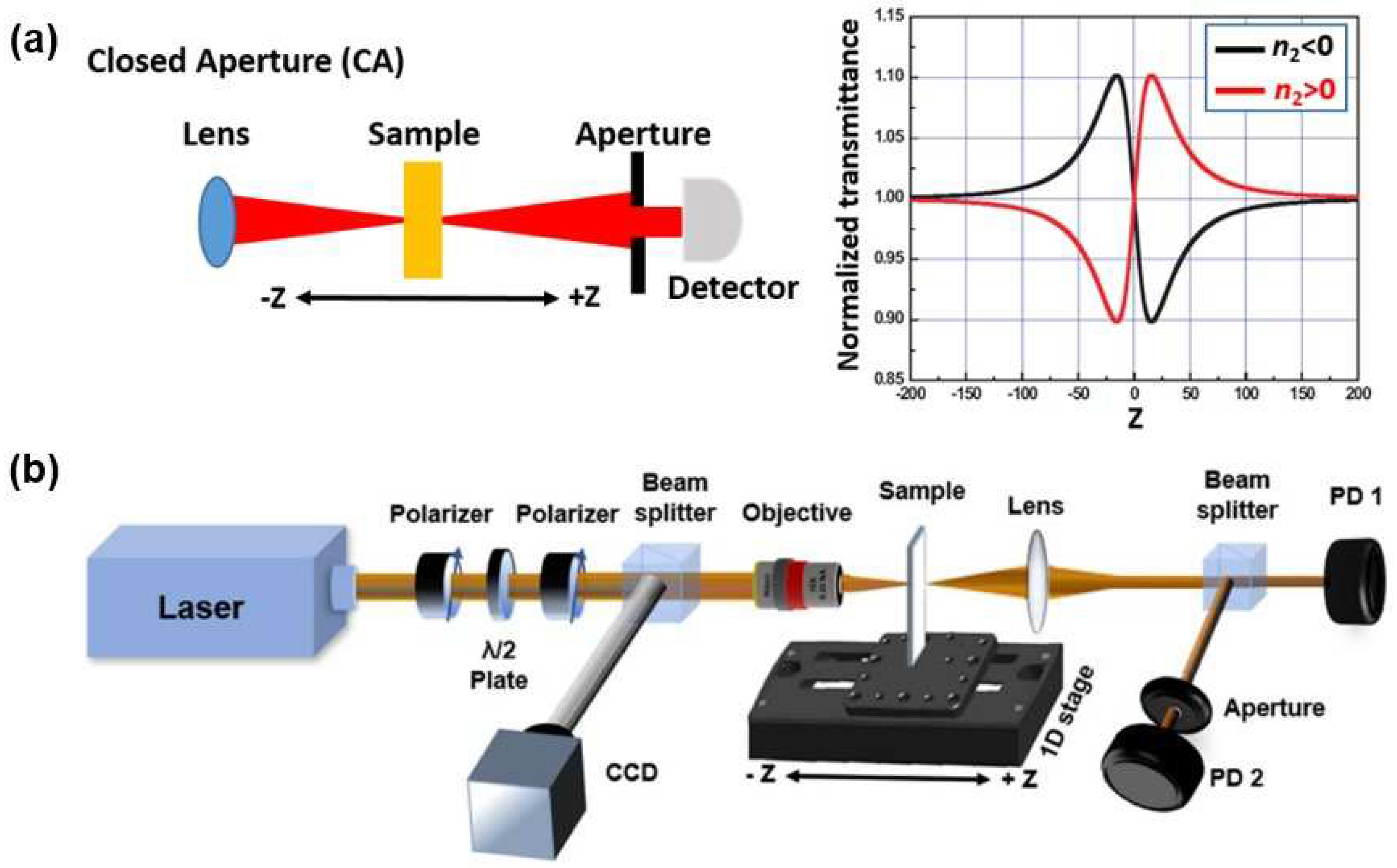
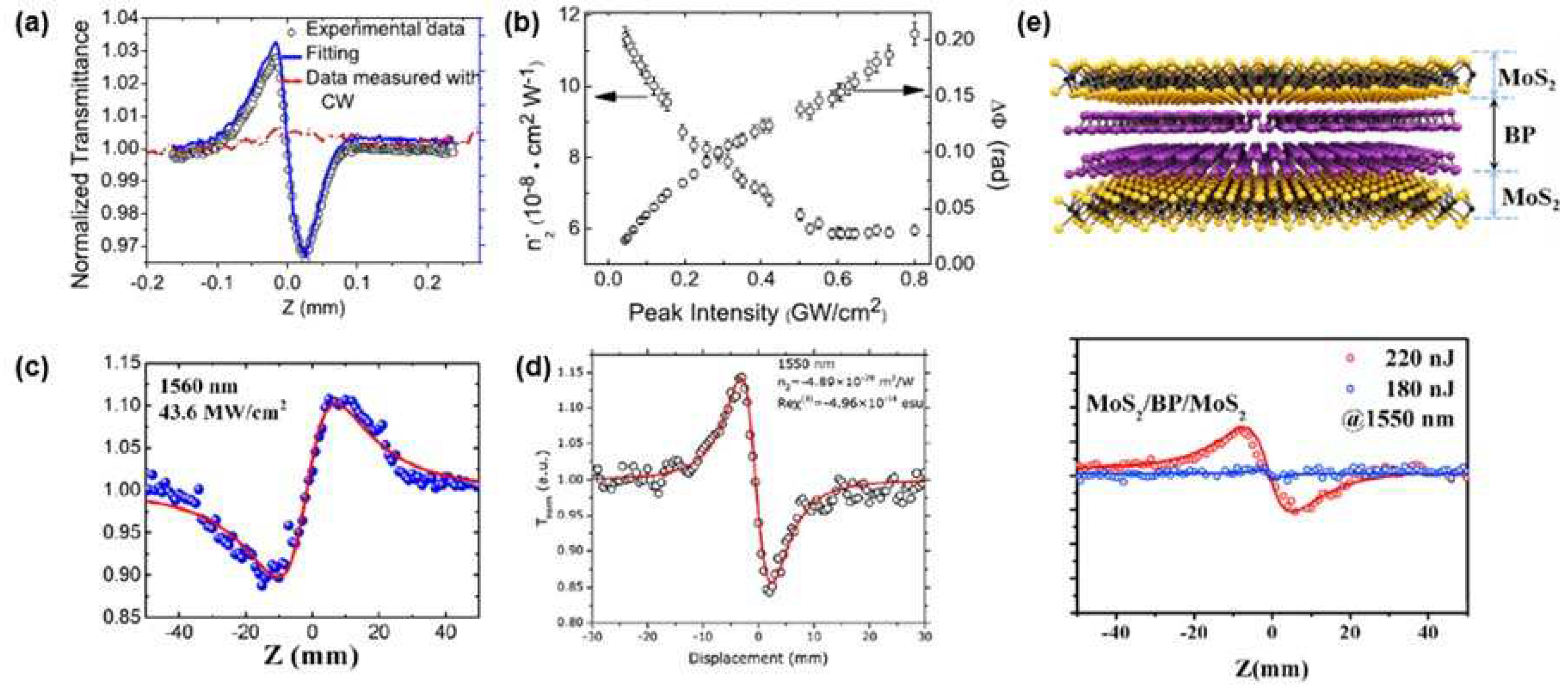
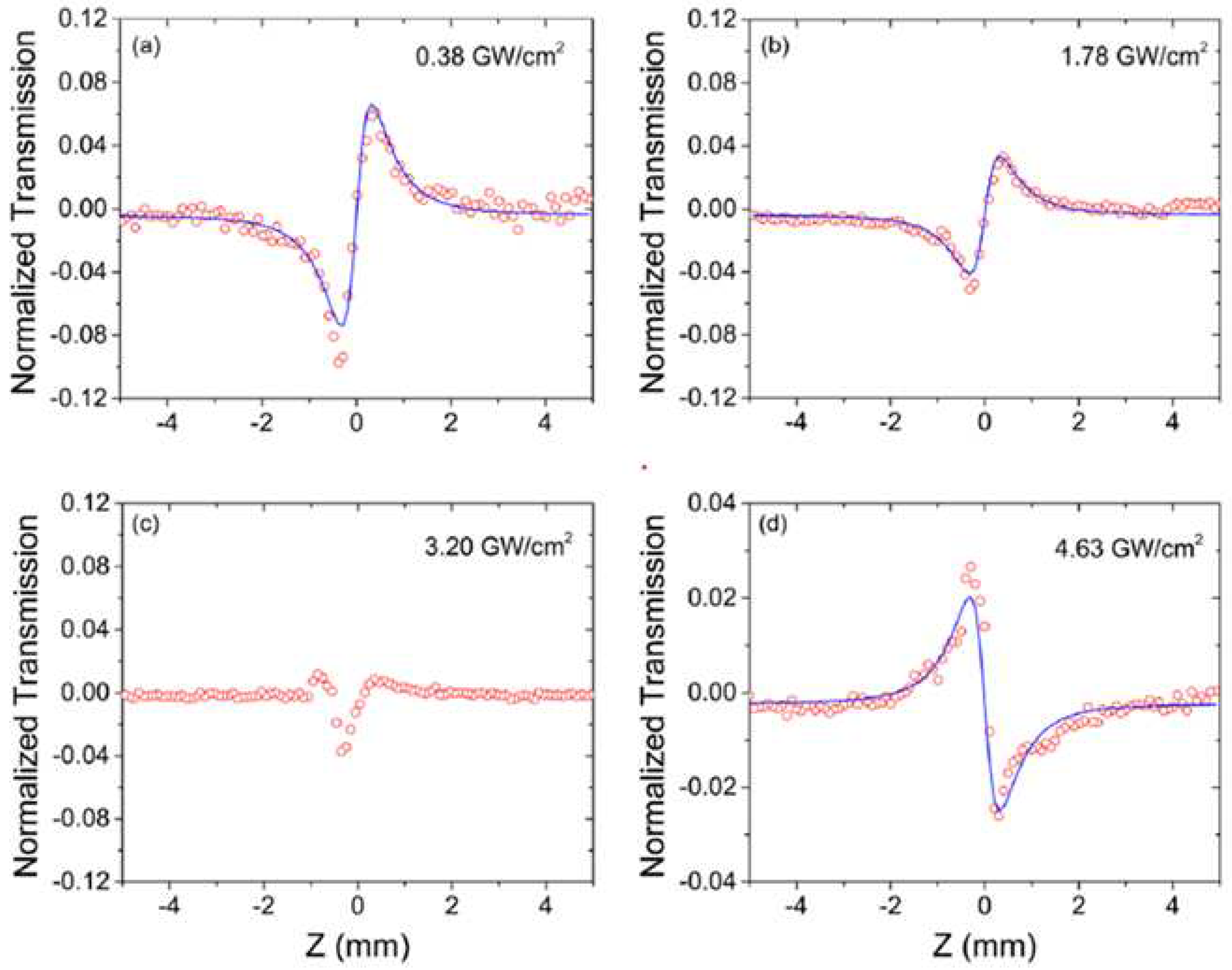
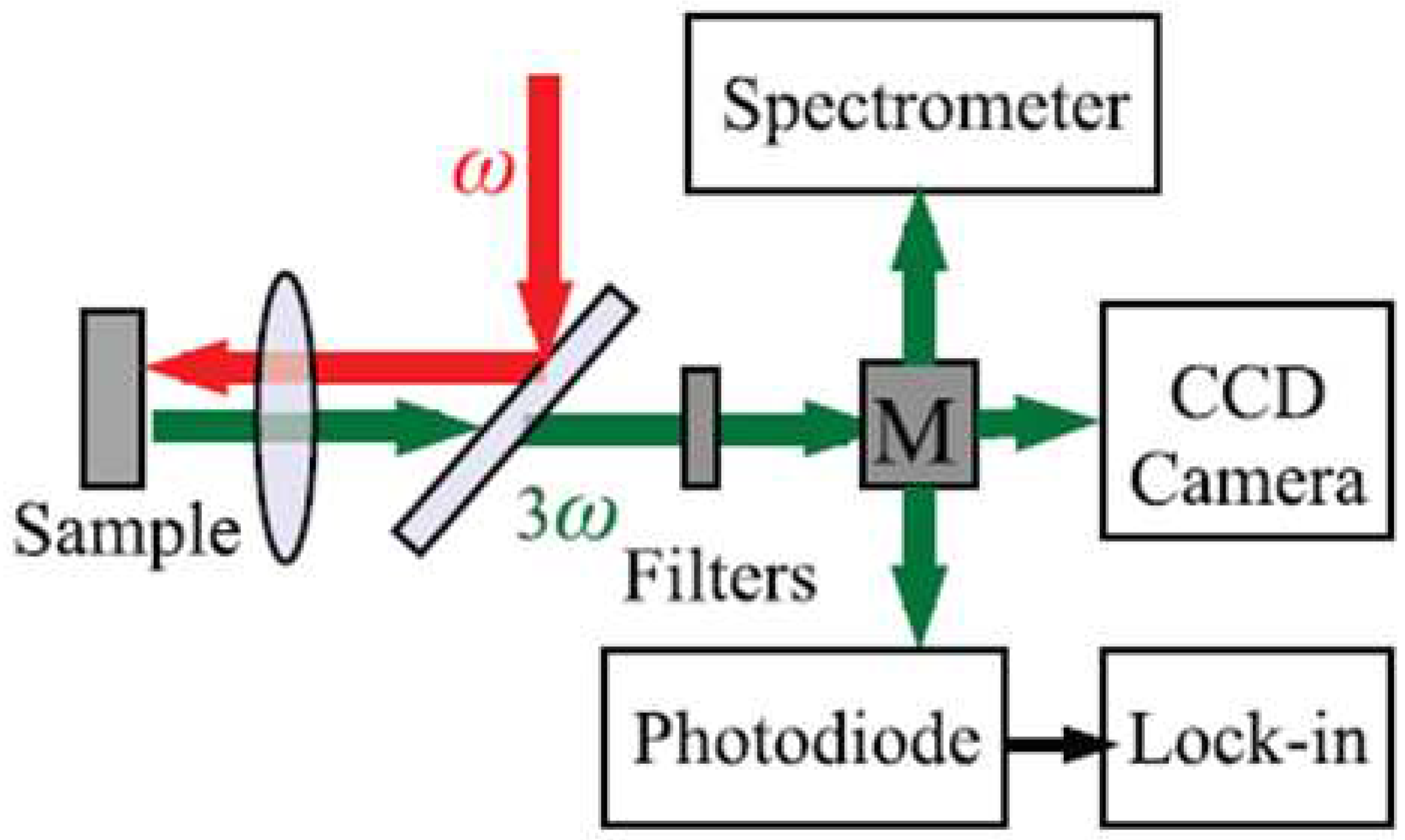
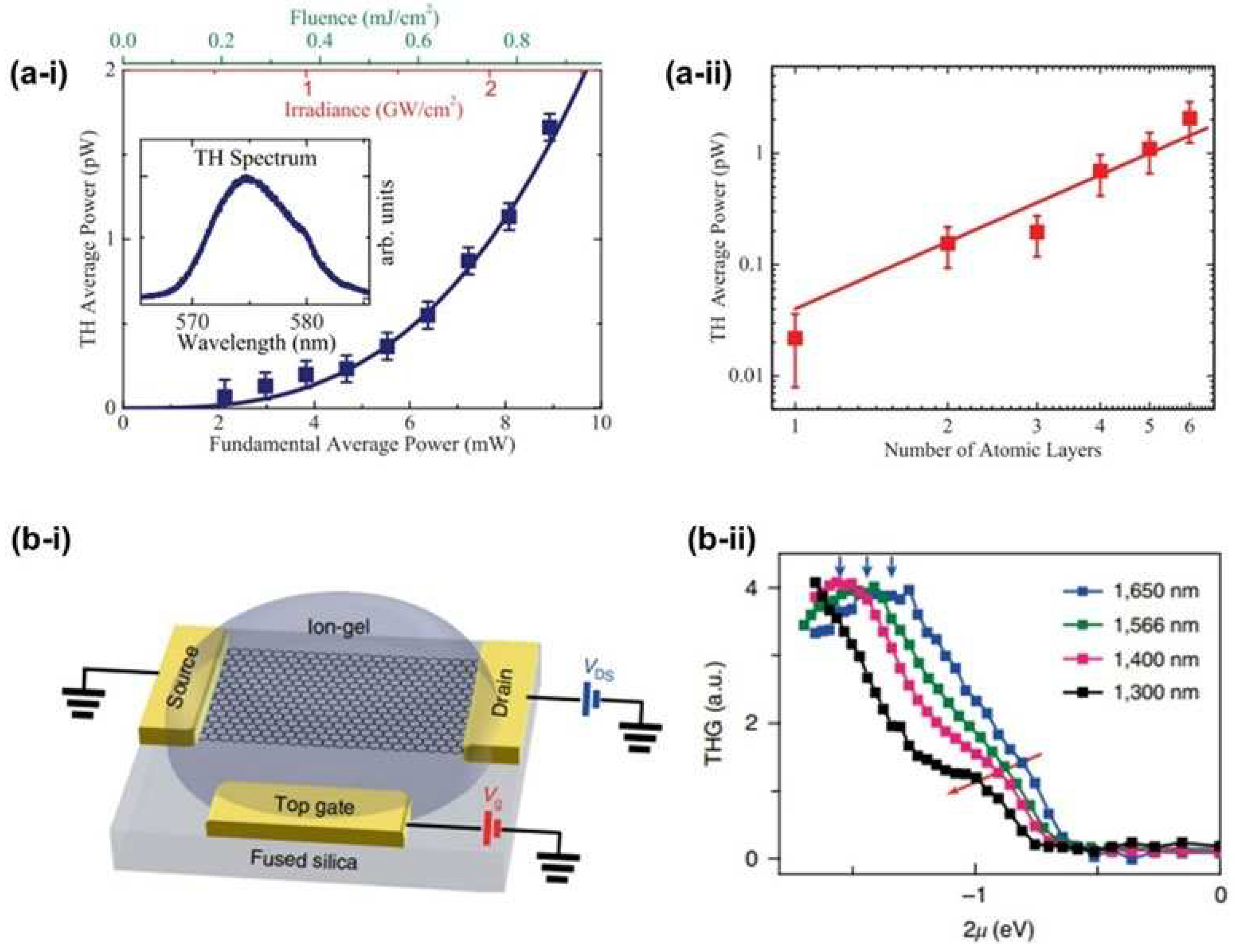
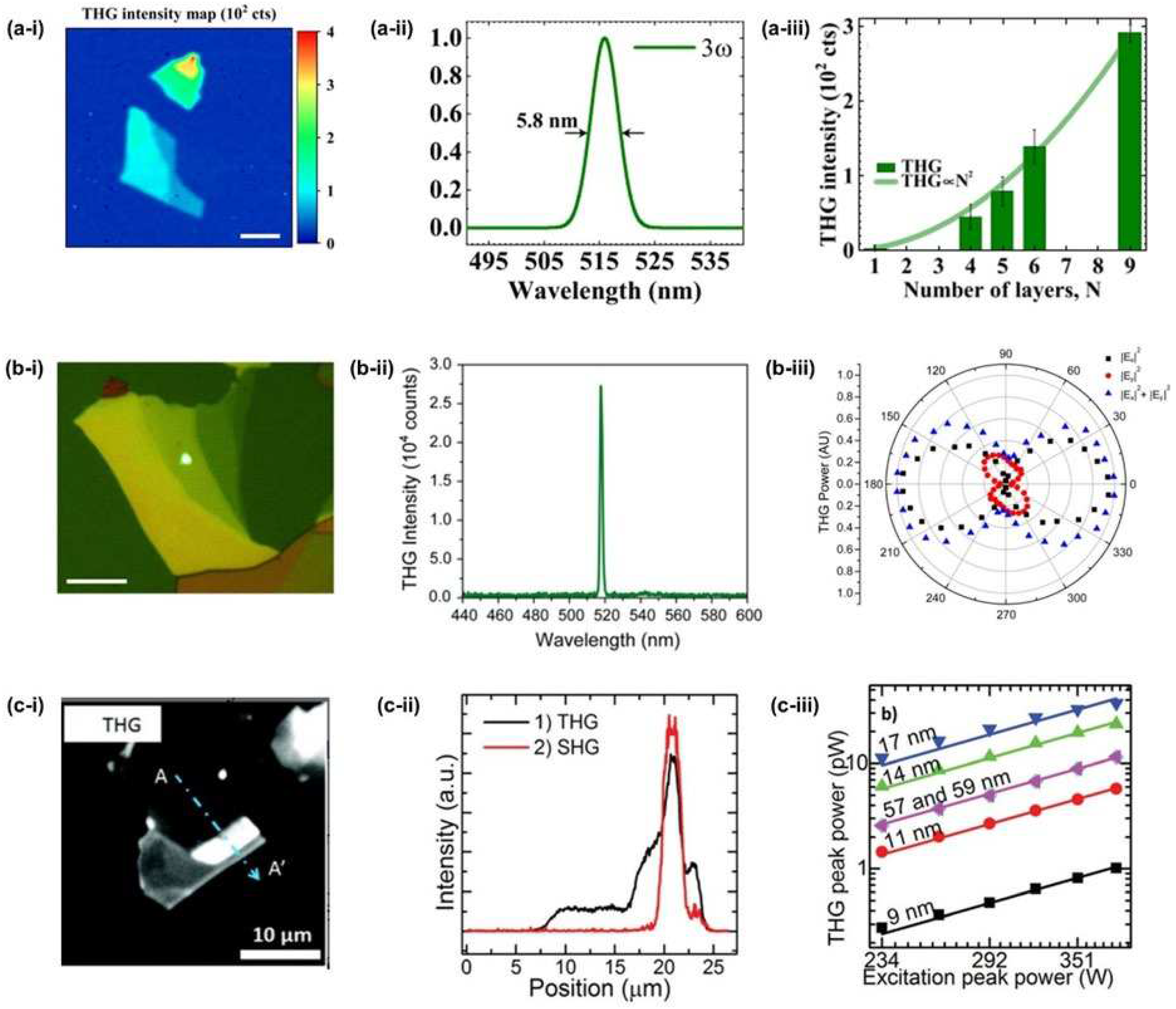
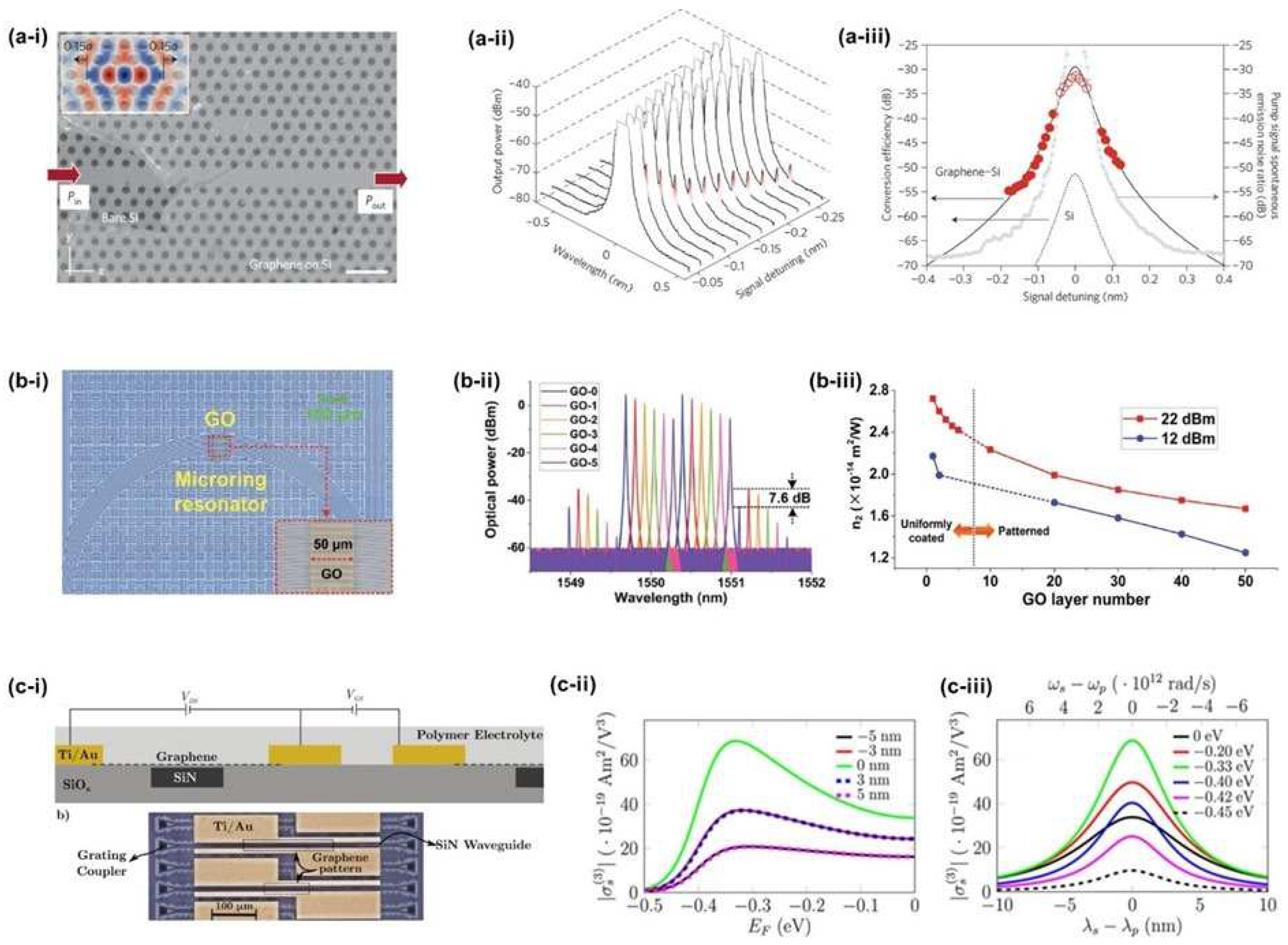
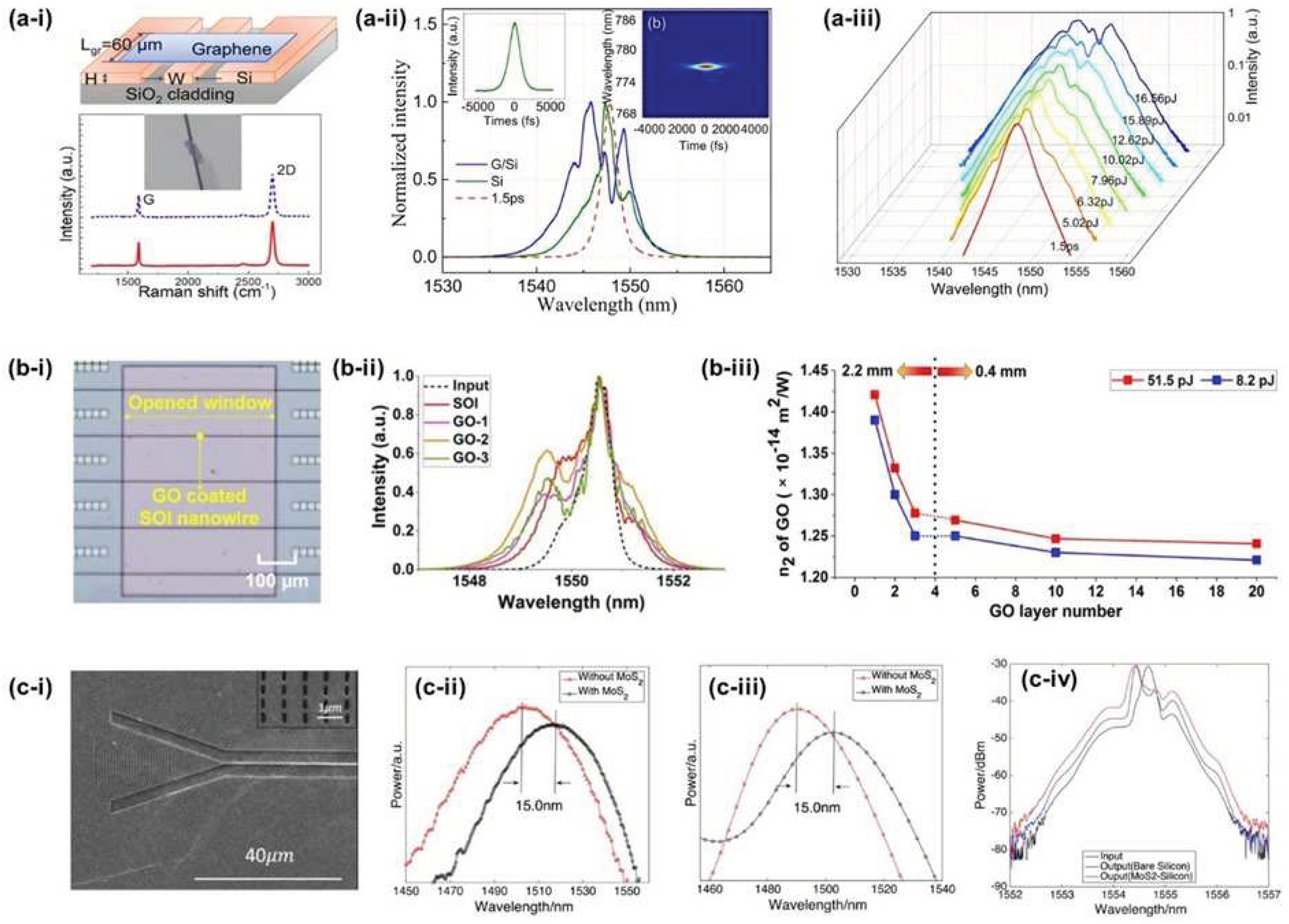
| Material | Wavelength a) | Thickness | Nonlinear parameter | Method | Ref. |
| Graphene | 1550 nm | ~ 1 layer | n2 = ~ 10−11 m2/W | Z-scan | [105] |
| Graphene | 1550 nm | ~ 5-7 layers | n2 = ~ -8 × 10−14 m2/W | Z-scan | [58] |
| GO | 1560 nm | ~ 1 um | n2 = ~ 4.5 × 10−14 m2/W | Z-scan | [60] |
| GeP | 1550 nm | ~ 15-40 nm | n2 = ~ 3.3 × 10−19 m2/W | Z-scan | [173] |
| CH3NH3PbI3 | 1560 nm | ~ 180 nm | n2 = ~ 1.6 × 10−12 m2/W | Z-scan | [106] |
| MXene | 1550 nm | ~ 220 um | n2 = ~ -4.89 × 10−20 m2/W | Z-scan | [57] |
| MOF | 1550 nm | ~ 4.2 nm | n2 = ~ -8.9 × 10−20 m2/W | Z-scan | [174] |
| MoS2/BP/MoS2 | 1550 nm | ~ 17-20 nm | n2 = ~ 3.04 × 10−22 m2/W | Z-scan | [107] |
| Graphene/Bi2Te3 | 1550 nm | ~ 8.5 nm | n2 = ~ 2 × 10−12 m2/W | Z-scan | [110] |
| Graphene | 1550 nm | ~ 1 layer | n2 = ~ 10−13 m2/W | SPM in WG | [175] |
| GO | 1550 nm | ~ 4 nm | n2 = ~ 1.5 × 10−14 m2/W | FWM in WG | [158] |
| GO | 1550 nm | ~ 2-100 nm | n2 = ~ (1.2-2.7) × 10−14 m2/W | FWM in MRR | [78] |
| GO | 1550 nm | ~ 2-20 nm | n2 = ~ (1.3-1.4) × 10−14 m2/W | FWM in WG | [159] |
| GO | 1550 nm | ~ 2-40 nm | n2 = ~ (1.2-1.4) × 10−14 m2/W | SPM in WG | [99] |
| MoS2 | 1550 nm | ~ 1 layer | n2 = ~ 1.1 × 10−16 m2/W | SPM in WG | [171] |
| Graphene | 1560 nm | ~ 1 layer | ꭓ(3) = ~ 4 × 10−15 m2/V2 | THG | [176] |
| Graphene | 1560 nm | ~ 1 layer | ꭓ(3) = ~ 1.5 × 10−19 m2/V2 | THG | [177] |
| MoS2 | 1560 nm | ~ 1 layer | ꭓ(3) = ~ 2.4 × 10−19 m2/V2 | THG | [177] |
| MoSe2 | 1560 nm | ~ 1 layer | ꭓ(3) = ~ 2.2 × 10−19 m2/V2 | THG | [178] |
| WS2 | 1560 nm | ~ 1 layer | ꭓ(3) = ~ 2.4 × 10−19 m2/V2 | THG | [178] |
| WSe2 | 1560 nm | ~ 1 layer | ꭓ(3) = ~ 1.2 × 10−19 m2/V2 | THG | [114] |
| SnSe2 | 1560 nm | multilayer | ꭓ(3) = ~ 4.1 × 10−19 m2/V2 | THG | [179] |
| ReS2 | 1515 nm | ~ 1 layer | ꭓ(3) = ~ 5.3 × 10−18 m2/V2 | THG | [180] |
| BP | 1560 nm | multilayer | ꭓ(3) = ~ 1.6 × 10−19 m2/V2 | THG | [181] |
Disclaimer/Publisher’s Note: The statements, opinions and data contained in all publications are solely those of the individual author(s) and contributor(s) and not of MDPI and/or the editor(s). MDPI and/or the editor(s) disclaim responsibility for any injury to people or property resulting from any ideas, methods, instructions or products referred to in the content. |
© 2023 by the authors. Licensee MDPI, Basel, Switzerland. This article is an open access article distributed under the terms and conditions of the Creative Commons Attribution (CC BY) license (http://creativecommons.org/licenses/by/4.0/).




